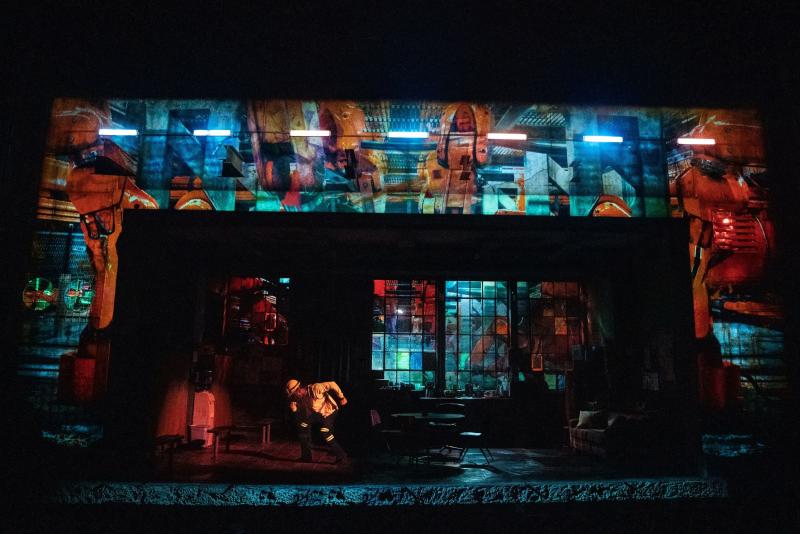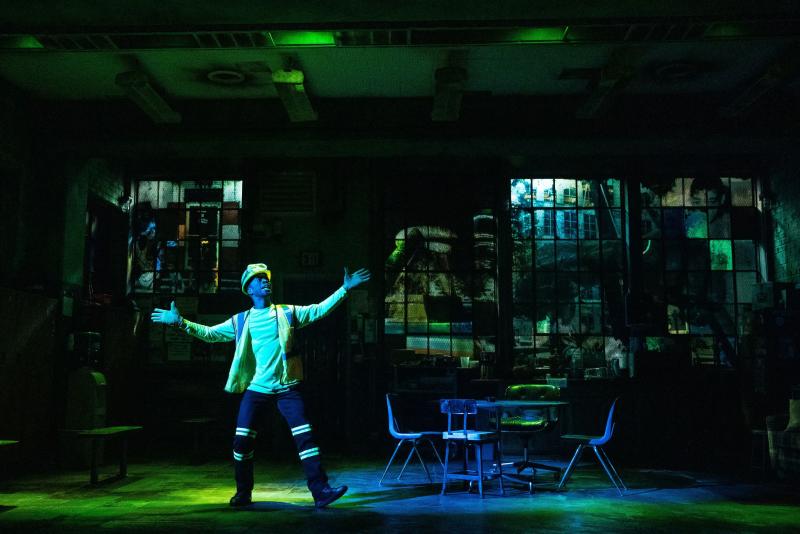Nicholas Hussong was co-nominated with scenic designer Michael Carnahan for the 2022 Tony Award for Best Scenic Design for his projection design for Skeleton Crew. Hussong works in theatre, opera, and music, as well as animation, editing, and photography, all influencing his creativity as a designer. His previous work includes projects for brands and networks such as CBS, Marc Jacobs, Complex Magazine, and AMC, as well as his recent role as a creative producer for Dwight Street Book Club. Live Design chats with the designer about his collaborative work on Skeleton Crew, nominated for the Tony for Best Play, which was produced by Manhattan Theatre Club and seen earlier this season at the Samuel J. Friedman Theatre. Phylicia Rashad took home the Tony for Best Performance by an Actress in a Featured Role in a Play.
Live Design: What was the brief from director Ruben Santiago-Hudson about the artistic intent for the projections in Skeleton Crew?
Nicholas Hussong: This our third time working on the piece, with a long break between off Broadway and Broadway. Each time, Ruben and I wanted to investigate the people, the culture, and the rich history of Detroit. We let the text guide us and tried to keep the energy moving, zooming out for the transitions and irising back in for the scenes. Ruben’s steady hand and sharp timing were pivotal in shaping the transitions between all the design departments
LD: Can you talk about your collaboration with set designer Michael Carnahan and lighting designer Rui Rita?
NH: The collaboration with Michael and Rui was fabulous. I am so thankful we had the same team on all three productions. It allowed us to grow and learn together, to create the best possible version each time. We were really able to build to the version that we presented on Broadway. It was a fascinating investigation into how we can really pull the audience into these characters during the scenes, and then explode out for the transitions. Michael used some very clever scenic elements, which helped Rui and I make each transition different and unexpected. This time around, Rui and I truly had the time to geek out on what color should be where and how to best present the dancer imagery that was happening around the set.
LD:. Projections or video? Gear list? Rental shop? Playback system? Projection surfaces?
NH: For Skeleton Crew, we wanted to use projections over video to give us the best chance of success incorporating it into the set and lights. The hope was that the projections would ooze from the walls of the factory break room, and that the history of Detroit would come alive when characters leave the stage. PRG provided the Watchout system, as well as one front 30k laser projector and two rear 12k laser projectors. The front projector covered the entire playing space and proscenium, while the rear projection surface encompassed the break room window and glass door. Michael incorporated a clever way of painting the plexi of the windows to be semi transparent and take projections.

LD: How do your images enhance the storytelling? How do they evoke Detroit in a visual way?
NH: Dominique's writing has the music of the factory floor at its core. JKeys and Rob brought those rhythms into the space - machines that can run smoothly but in our story haven’t found the right rhythm, yet. Ruben asked the brilliant dancer and choreographer Adesola to help bring the factory rhythms and hiccups to visual life. We took Adesola’s lead and used a 3D artist to animate a factory floor, engaging the machines in choreography and movement. This collaboration allowed us to create a dynamic visual experience of the factory
LD: Particular challenges on this production?
NH: Covid was a major challenge that I think every production has and continues to navigate. We, as well as many others, had delays and had to be very creative on how to continue the work without sacrificing safety or while members of the team were in isolation. MTC and the production management team did a remarkable job of problem solving and making the best decisions with the information we had in January to get this show on its feet. I had the good fortune to work with a fantastic not for profit that had the best interest of the artists, technicians, and understudies in mind. Without their support we never would have made it to opening.
I think another challenge worth talking about, which I mentioned earlier, was creating the feeling of the factory in the transitions. Our team did a tremendous amount of research to find the right feel of the factory that fit Dom’s words and Ruben vision. Eventually, we decided to hire a 3D artist to give us more control of the movement and speed, as well as alleviate some potential copyright issues. Once we had the factory in 3D, we could have it match any of the choreography and music with relative ease. Not to mention we could do some fun things with the lighting that we might not have otherwise been able to do.

LD:. What do you think made your work on this show Tony nomination worthy?
NH: I think this is a tricky question, I think I try and make every show to the best of my ability. I am very thankful that Skeleton Crew was able to open in a difficult time and reach so many audiences. I am honored and humbled by the nomination and I can’t thank MTC Dominique Morisseau, Ruben, the creative team, and my team Blake Manns and Joey Moro that helped make the good work.